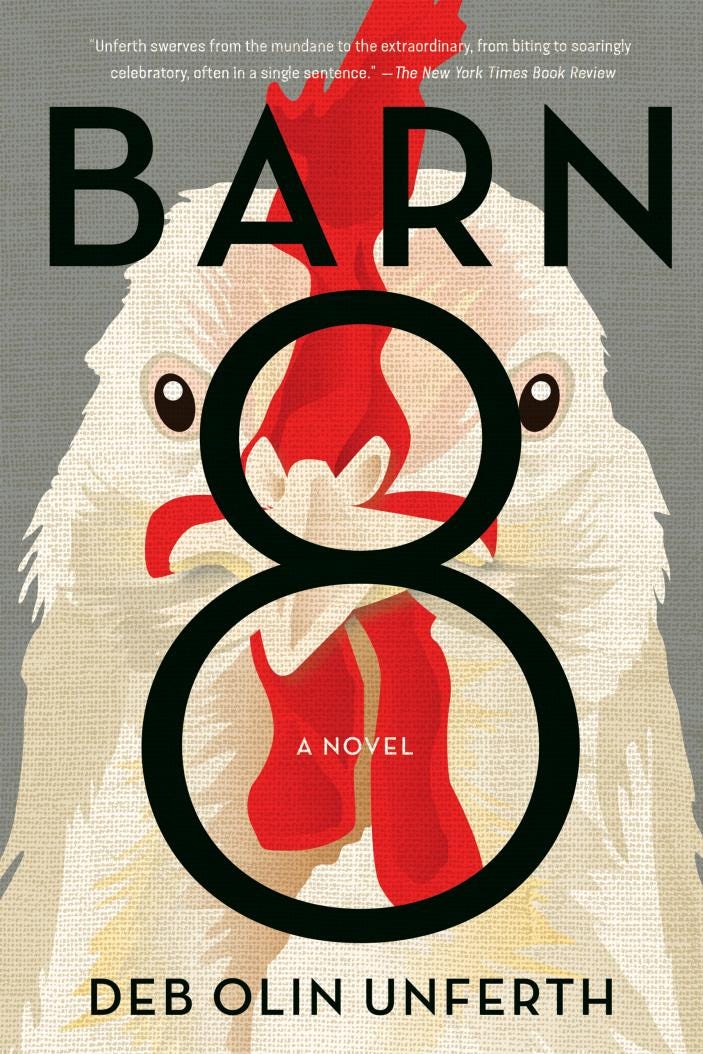Deb Olin Unferth’s 2020 novel, Barn 8 is a caper, a comedy, and a relationship tale that’s also a powerful meditation on what it means to live with a scientific understanding of the world.
The plot is that Janey and Cleveland, who audit chicken farms for the United States Department of Agriculture, decide to pull off the a massive heist to liberate 1 million captive egg-layers. It’s a fun novel, but The Middlebrow would like to quote at length from a section where the book veers towards eco-fiction and epistemology:
“Here’s a question: Who cares? It’s just a bunch of stupid chickens.
But chickens. did not always have the reputation of being dirty, ugly, and dumb, a practical version of the pigeon. That’s a uniquely 20th century construction. Until recently, chickens commanded respect. Roosters, of course, were warriors and leaders since the earlier images of them on the pharaoh’s walls in Egypt. Hens were devoted mothers, teachers, and nurturers — in India, China, the Mediterranean.
The hen in ancient mythology, scratching through water and sand to bring the world into being.
The hen, protector of creation. Her egg, a symbol of life, resurrection. Inevitable, yet fragile.
All through the Middle Ages and the Renaissance, it was always the hen — her loyalty, her vigilance, her love. She came out the other side of the Reformation as the Protestant hen — thrifty, tidy, industrious, pious. Observe the way she used every stick and morsel in the barnyard and woods for nesting and caring for her babies! Admire the compact egg with its perfect chick nutrition!
In nineteenth-century England, people went mad for hens and the vogue spread to the United States. The era was known as the “hen craze.” Her beauty, her plumage, her proud vanity. At the first Boston Poultry Exposition in 1849, ten thousand people paid four pennies each to stroll the Public Garden, study a thousand chickens of all breeds and sizes assembled in tents a hundred feet long. These shows were wildly popular for decades across the country and abroad, straight through the First World War.
Only then, at the business end of history, did the hen’s standing begin to fall, correlating to when we began putting them into cages and out of sight.”
The Middlebrow has just asked you to read a lot about chickens, but in this passage I think Olin Unferth perfectly captures the transformation of human thought that occurs when the scientific and industrial worldview takes hold of a topic. The hen transforms from goddess to prisoner, from the focus of our awe to a commodity to be moved around, stored, used and disposed of.
That the scientific/industrial view does this throughout history and the world isn’t a new insight or even deniable. Enchanted forests lose their enchantments. Any notion of a spirit world becomes a whimsy.
It’s interesting that the recently successful horror movie M3gan has a completely technological villain. There is no demon that enters the machine or damned soul of a serial killer that infects a doll as in the Child’s Play series. Even Frankenstein, is fundamentally about the dignity and soul of the monster. There’s no discussion of a soul behind M3gan she’s just a super-powered doll with an artificial intelligence run amok and that, combined with the motivations of a profit seeking corporation, is more than enough for a 2023 horror tale.
At the end of Barn 8, Olin Unferth expands the scope of her story. The result of the caper, combined with humanity’s failure to address climate change, leads to a bigger story about chickens and their place in the world and about how wild spaces cannot be contained by an industrial strategy.


